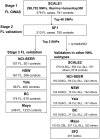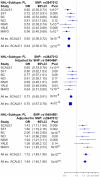GWAS of follicular lymphoma reveals allelic heterogeneity at 6p21.32 and suggests shared genetic susceptibility with diffuse large B-cell lymphoma
- PMID: 21533074
- PMCID: PMC3080853
- DOI: 10.1371/journal.pgen.1001378
GWAS of follicular lymphoma reveals allelic heterogeneity at 6p21.32 and suggests shared genetic susceptibility with diffuse large B-cell lymphoma
Abstract
Non-Hodgkin lymphoma (NHL) represents a diverse group of hematological malignancies, of which follicular lymphoma (FL) is a prevalent subtype. A previous genome-wide association study has established a marker, rs10484561 in the human leukocyte antigen (HLA) class II region on 6p21.32 associated with increased FL risk. Here, in a three-stage genome-wide association study, starting with a genome-wide scan of 379 FL cases and 791 controls followed by validation in 1,049 cases and 5,790 controls, we identified a second independent FL-associated locus on 6p21.32, rs2647012 (OR(combined) = 0.64, P(combined) = 2 × 10(-21)) located 962 bp away from rs10484561 (r(2)<0.1 in controls). After mutual adjustment, the associations at the two SNPs remained genome-wide significant (rs2647012:OR(adjusted) = 0.70, P(adjusted) = 4 × 10(-12); rs10484561:OR(adjusted) = 1.64, P(adjusted) = 5 × 10(-15)). Haplotype and coalescence analyses indicated that rs2647012 arose on an evolutionarily distinct haplotype from that of rs10484561 and tags a novel allele with an opposite (protective) effect on FL risk. Moreover, in a follow-up analysis of the top 6 FL-associated SNPs in 4,449 cases of other NHL subtypes, rs10484561 was associated with risk of diffuse large B-cell lymphoma (OR(combined) = 1.36, P(combined) = 1.4 × 10(-7)). Our results reveal the presence of allelic heterogeneity within the HLA class II region influencing FL susceptibility and indicate a possible shared genetic etiology with diffuse large B-cell lymphoma. These findings suggest that the HLA class II region plays a complex yet important role in NHL.
Conflict of interest statement
The authors have declared that no competing interests exist.
Figures




References
-
- Jaffe ES, Harris NL, Stein H, Vardiman J. Lyon: IARC Press; 2001. World Health Organization classification of tumours pathology and genetics, tumours of hematopoietic and lymphoid tissues.
-
- Altieri A, Bermejo JL, Hemminki K. Familial risk for non-Hodgkin lymphoma and other lymphoproliferative malignancies by histopathologic subtype: the Swedish Family-Cancer Database. Blood. 2005;106:668–672. - PubMed
-
- Chang ET, Smedby KE, Hjalgrim H, Glimelius B, Adami HO. Reliability of self-reported family history of cancer in a large case-control study of lymphoma. J Natl Cancer Inst. 2006;98:61–68. - PubMed
MeSH terms
Substances
Grants and funding
LinkOut - more resources
Full Text Sources
Research Materials

